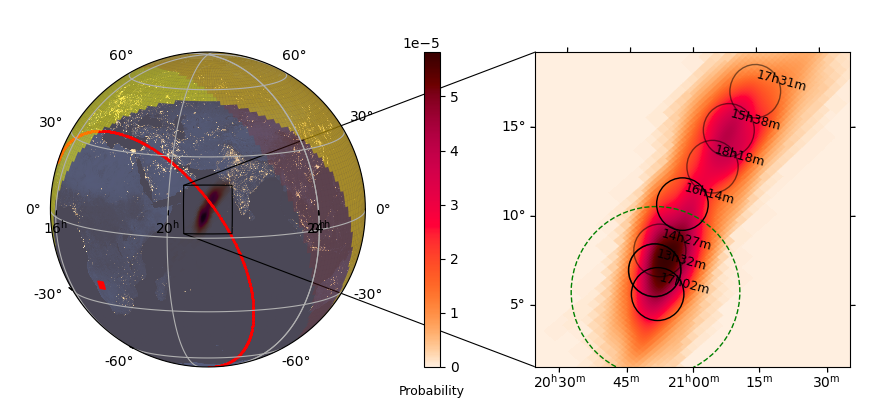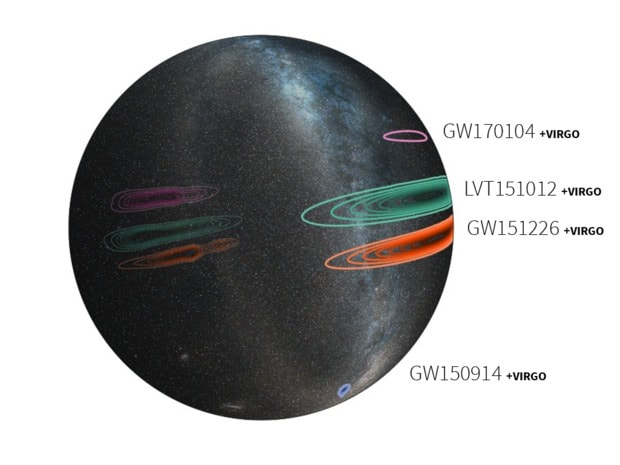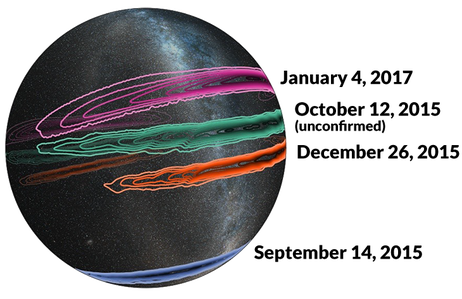|
This post is largely based on the "Source of the Month" article that was prepared by Halim Ashkar and the H.E.S.S. GW follow-up task force and which was published on the website of the H.E.S.S. Collaboration in January 2022. Gravitational Waves (GWs) are produced by the coalescence of compact objects like neutron stars and black holes. These events are in no doubt in the list of the most cataclysmic events in the Universe. GW events are also promising candidates for producing very high energy (VHE) emission through particle acceleration processes. This is why H.E.S.S. dedicates a large amount of observation time to the follow-up of GWs. In a recent publication (available here and via the arXiv), we describe the methods and procedures put in place to conduct these challenging observations in an optimal way. The developed algorithms have been put to the real-life test over the last years during several observation runs of the GW interferometers Ligo and VIRGO. Artists impression of a binary black hole system producing gravitational waves. (Image credit: LIGO/Caltech/MIT/Sonoma State, Aurore Simonnet) Thanks to these detailed preparations, H.E.S.S. was the first ground-based instrument to observe the event GW170817 [1-3] on 2017 August 17, the neutron star merger that was accompanied by a gamma-ray burst. These observations resulted in the first stringent upper limits on the VHE emission from a neutron star merger. Details about this amazing event and our observations can be found in previous blog post: the-birth-of-multi-messenger-astrophysics.html Since 2017, H.E.S.S has also observed four merger events of two black holes. Black hole mergers are not typically expected to produce gamma-ray emission because, due to long merger times, most of the surrounding matter has been accreted before the merger happens. However, a weak gamma-ray transient detected by the gamma-ray telescope Fermi-GBM [4] less than half a second after a merger of two black holes triggered much interest in the astrophysical community and encouraged the search for VHE emission from such events. Moreover, GW signals from black hole mergers are detected much more often than from neutron star mergers and are therefore a good way to test H.E.S.S.'s response to GW events. The four observations reported in another paper published in 2021 have allowed us to commission the H.E.S.S. GW follow-up program and to improve it for future observations. The paper itself is available here and via the arXiv. The localization regions of GW sources can span several tens to hundred of square degrees in the sky, while the H.E.S.S. field of view is around 20 square degrees. Therefore, follow-up observations of GW alerts are challenging and require special strategies to be implemented. These strategies are detailed in [5]. In a nutshell, the goal of these observation strategies is to identify the regions that are most likely to have hosted the event of the GW event, taking into consideration the visibility and observational constraints of the H.E.S.S. telescopes. H.E.S.S. coverage of the GW190728_064510 event. The project of the GW event localization on Earth is shown on the left at the time of start of the observation. The yellow and brown patches indicate the regions where light from the Sun and Moon, respectively, was too bright to allow for H.E.S.S. observations. The red square indicates the location of the H.E.S.S. telescopes and the red line indicates the region of the sky that was visible to H.E.S.S. The sky map with the probability of the position of the event together with the fields-of-view of individual H.E.S.S. observations (black circles) is shown on the right.The green dotted circle is a neutrino candidate detection by IceCube [10]. Only alerts of GW events whose localization regions do not exceed a few hundred degrees in the sky are picked for observation by our algorithms; otherwise, the region would be too large to cover in a manageable time. H.E.S.S. was able to schedule observations on several GW events. However, nature is not always on our side, and clouds and rain disturbed two of these observations. In total, and in addition to GW170817, four successful observations were performed on four different black hole mergers: GW170814 [6-7] in 2017 during the second GW observing period, GW190512_180714 and GW190728_064510 in 2019 during the first part of the third observation period [8] and GW200224_222234 in 2020 during the second part of the third observing period [9]. Electromagnetic counterparts of these events were never found by the astronomical community and thus they remain poorly localized. However, H.E.S.S. was able to cover large portions of their localization regions which increases the chance of having covered the true positions of the events. The start of the H.E.S.S. observations ranges from three hours after the detection of the event GW200224_222234 to two days for GW170814. No significant VHE signal was found but the good quality data obtained permit us to compute upper limits on the VHE gamma-ray emission in the sky regions covered by H.E.S.S. [11-12]. These upper limits constrain for the first time VHE emission from black hole mergers. In the future the interpretation of upper limits can be eased by having earlier and longer observations. Assuming that the H.E.S.S. observation strategy remains the same, and due to the expected high rate of GW detections with additional and/or more sensitive detectors in the future, H.E.S.S. will have on average the chance to observe several GW events with minimal delay. Moreover, the localization of GW events is expected to improve as more GW detectors join the network, which means that some of these events will be sufficiently well localized that they will be able to be observed with a single pointing. This will allow us to spend more time on one individual position and obtain longer, more sensitive observations, instead of spending time on covering large areas in the sky. In conclusion, this will result in stronger constraints on the VHE emission from black hole mergers. All this will hopefully become a reality during the next observation run of the Ligo/VIRGO/KAGRA interferometers that is scheduled to start end of 2022. References
0 Comments
On August 17, 2017, the gravitational wave interferometers Advanced Ligo and Advanced Virgo recorded a signal from the merger of a binary neutron star system, a type of signal that had never been seen before. Complementing this exciting discovery, a large variety of electromagnetic observations were able to record signals from the same event. They range from the detection of a gamma-ray burst about 2 seconds after the gravitational wave event, over near-infrared, optical and UV emission from decay of radioactive nuclei created in the resulting kilonova to X-ray and radio emissions detected several days and weeks after the event. This first and extremely successful observation campaign is marking the beginning of multi-messenger astrophysics. Observatories that participated in the observations following the detection of gravitational waves from the merger of a binary neutron star system. Can you spot H.E.S.S.? Source: LIGO/Virgo The gravitational wave event was localized within a region of about 30 square degrees, well beyond the H.E.S.S. field of view and requiring multiple pointings to cover the area. We (Monica, my PhD student and myself) rushed to apply the target selection algorithms that we had prepared and identified regions of high probability to find a counterpart of the gravitational wave event. We were able to request H.E.S.S. observations in record time (only 5minutes after the publication of the localisation of the gravitational wave event by Virgo/Ligo!!). Our observations thus started only 5.3h after the gravitational wave event GW170817. The covered regions already contained the counterpart SSS17a that has later been identified in the optical domain, several hours after our observations (see Figure below). As a result, H.E.S.S. was the first ground-based pointing instrument to obtain data on this object. A subsequent monitoring campaign with the H.E.S.S. telescopes extended over several days, covering timescales from 0.22 to 5.2 days and energy ranges between 270 GeV to 8.55 TeV. No significant gamma-ray emission has been found within this time interval. The derived upper limits on the very-high-energy gamma-ray flux for the first time constrain non-thermal, high-energy emission following the merger of a confirmed binary neutron star system, and further observations of this source will allow to check whether TeV energies are reached on a larger time scale. Left: Pointing directions of the first night of H.E.S.S. follow-up observations starting August 17, 2017, at 17:59 UTC. The circles illustrate a FoV with radius of 1.5 deg and the shown times are the starting times of each observation with respect to GW170817. The localisation map of GW170817 is shown as colored background, the red lines denote the uncertainty contours of GRB170817A. Right: Map of significances of the gamma-ray emission in the region around SSS17a obtained during the first H.E.S.S. observation of GW170817. The white circle has a diameter of 0.1deg, corresponding to the H.E.S.S. point spread function and also used for the oversampling of the map. Figure from Abdalla et al. (H.E.S.S. Collaboration), submitted to ApJL Following the observations, we rapidly transferred the data from Namibia to Europe for analysis. After some troubles due to hard-drives that were crushed during the shipping, we managed to carefully analyse the dataset in record time. In parallel we prepared a publication that (again in record time) has been submitted to ApJLetters right in time for the announcement of the gravitational wave event and the extensive follow-up campaign. The paper can be found on the arXiv tonight. For the very impatient ones it is already available on the H.E.S.S. website (incl. a short news article I wrote).
We also were able to contribute to a paper that has been prepared jointly by all observatories and collaborations contributing to these unprecedented observations. This paper can be found here: "Multi-messenger observations of a Binary Neutron Star Merger". It is definitely a milestone in astrophysics and will be regarded as the birth of multi-messenger astrophysics... After spending several years on the preparation of the H.E.S.S. multi-messenger program (see Multimessenger searches for more details), this event together with the multi-messenger and multi-wavelength observation campaign and the successful H.E.S.S. participation is extremely exiting and rewarding for my colleagues, friends and me personally... The dreams we were chasing for the last years (and that have been treated as such by many within the more main-stream astrophysics community) have suddenly materialized and become a reality. Exciting times ahead: the Virgo and Ligo interferometers are currently not taking data but are undergoing upgrades and further improvements. They should be restarting physics observations in summer 2018 with the prospect to detect many more events of this kind. After the frenzy of the weeks since the detection of GW170817, this break is obviously highly appreciated ;-) We'll also use it to further improve the response of high-energy gamma-ray instruments like H.E.S.S., CTA and HAWC to these events. You can even become part of this endeavor: see Team / open positions for details and don't hesitate to contact me (Contact). Exciting times ahead... The Advanced Ligo and Advanced Virgo observatories announced the first detection of a gravitational waves that has been recorded by all three interferometers simultaneously. The paper describing the event has been published by PRL. The merger event itself, a binary black hole composed of a black hole with ~30 solar masses and another one with ~25 solar masses at a redshift of about 0.1, are matching nicely the previous detections: The crucial part of this detection is that is has been seen by all three instruments. It is thus confirming the performance of the Virgo instrument that had been switched on only two weeks before this observation. It also illustrates the power of combining the data from the different instruments to significantly improve the localisation uncertainty of the origin of the gravitational wave. Using only data from the two Ligo detectors, the 90% uncertainty maps spans 1160deg^2 across the sky, impossible to scan with typical telescope searching for a counterpart/afterglow/etc. Adding the data from Virgo this region shrinks to less then 100deg^2!! This improvement is clearly visible in the skymaps below.
Regions of this size become accessible for pointing telescopes. As example: we managed to cover almost the complete region with H.E.S.S. observations searching for high-energy gamma rays emitted by the black hole merger. As everybody else we didn't see any... See GCN #21673 for a summary of our observations. The importance of this event is thus primarily its illustration of the achieved precision of the GW localisation allowing for follow-up observations across the electromagnetic spectrum. Astronomy with gravitational waves is thus becoming a reality... Stay tuned for more... There are now three laser interferometers observing the universe with gravitational waves! The first direct detection of gravitational waves by the two Advanced Ligo detectors in 2015 was recently confirmed by a third event (see here for details). Having only two interferometers recording the events, the localisation uncertainties of the sources was very challenging (see the right figure below). This is now going to change: "Tuesday August 1st 2017, the VIRGO detector located at the European Gravitational Observatory (EGO) in Cascina (near Pisa, Italy) has officially joined the “Observation Run 2” (O2) and is now taking data alongside the American-based twin LIGO detectors. The O2 data taking period will last until August 25th." (from Virgo).
The expected improvement in the localisation accuracy is visualized in the (simulation based) estimate by Leo Singer shown below (left figure, from Ligo). We keep our fingers crossed that the joint duty-cycle of the three detectors is sufficiently high and that nature is kind enough to send us another strong gravitational wave signal in the few weeks until the end of the current data taking run... Source: Science News The Ligo/Virgo collaboration just published a paper describing the detection of the third gravitational wave!! I won't try to compete with the many very well written blogs around the world describing the event and its astrophysical implications. See for example:
Also note that another crucial piece of information has been published at the same time: the full history of the searches for a coincident (or delayed afterglow-like) signal as reported in a large set of GCN-Notices. A significant number of observatories around the world and across the full electromagnetic spectrum, as well as both major high-energy neutrino telescopes, i.e. incl. ANTARES ;-), reacted to the alert sent out by Virgo/Ligo shortly after the detection of the event in early January 2017. Unfortunately none has detected significant emission... For various reasons we were not able to follow this event with H.E.S.S.. Some details about our preparations for events like this are given here: Multimessenger searches
|
AuthorMyself ;-) Archives
January 2024
Categories
All
|












 RSS Feed
RSS Feed